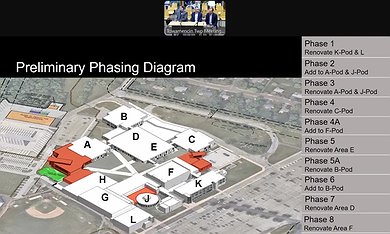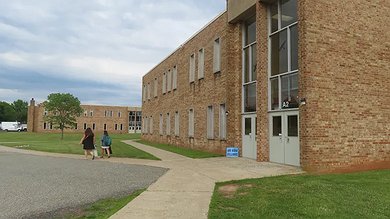Members of the North Penn Marching Knights perform outside North Penn High School as staff return to school for the district’s convocation ceremony in Aug. 2024.
Staff say former radio site could be used for construction staging.
Kids are back in school, those buses are back on the road, and September could bring major movement on long-discussed plans to renovate North Penn High School.
District officials gave an update in late August on next steps, including details the public could see and hear starting later this month.
“We really feel as if we’re going to have a good handle on a good portion of the phase one construction, and then also the phase two construction: how it’s going to be phased, and how we’ll be moving around the building,” said Tom Schneider, the district’s director of facilities and operations.
Throughout 2023 into 2024, district staff and the school board argued for a voter referendum that would have approved tax increases necessary to fund an expansion of the school to move ninth graders there. After voters rejected that referendum in January, the district changed gears, presenting a new plan starting in March that would add a new wing to the current high school, minor additions to two other classroom areas, and fully renovate and upgrade the rest of the complex.
In July, administrators said the renovations would not include a move of the district’s transportation center to another site in the district, after talks about two potential sites fell through due to costs, and in late June the district gave Towamencin’s supervisors an update on the latest versions of the plans.
During the school board’s facilities and operations committee meeting in late August, Schneider gave another update, saying earlier that month district staff gave an updated presentation to Towamencin’s planning commission, which had questions about parking on the site and the location of the transportation building.
“It was, overall, well-received, and we are planning to submit a preliminary plan to the township for the next steps in the planning and land development process,” he said.
Ongoing meetings are being held between district administrators, the architect, and the project construction manager to finalize plans and go over the construction schedule, which looks likely to include an early contract for renovations to the school’s 1990s-era K-pod first, possibly as soon as summer 2025, before construction of the new wing and major renovations to the school’s remaining pods.
 North Penn School District officials, inset, show Towamencin’s supervisors an outline of North Penn High School, the school’s various “pods” lettered, potential new additions outlined in red, and a possible renovation timeline at right, during the June 26, 2024 township supervisors meeting.
North Penn School District officials, inset, show Towamencin’s supervisors an outline of North Penn High School, the school’s various “pods” lettered, potential new additions outlined in red, and a possible renovation timeline at right, during the June 26, 2024 township supervisors meeting.“A lot of the things that we’ve been talking about recently include how many classrooms can we take offline at one time, to renovate the pod? Where can we have temporary classrooms? For example, possibly in the auditorium, or have classrooms in the audion — things like that,” Schneider said.
The first bid package “is on schedule” to be finished by December, bids open likely in January, and the contract could be awarded in early 2025 in time for renovations to K-pod to be done that summer, because those renovations do not require formal land development approvals, then a second bid package would address the rest of the school.
In an online livestream in late August, Superintendent Todd Bauer gave a behind-the-scenes look at the planning underway now, and what that construction could look like.
“We’re having department chairs from, say, the math department, or the special education department, or the science department, come in and help us design those rooms. What kind of case work, what kind of furniture do they need, all those things,” Bauer said.
“I do think a lot of the staging will be located on the WNPV property. Even that building itself, that little tiny building,” which until 2020 housed WNPV’s broadcast studio and offices, “could be used as an office for the construction manager. We’re working out all those logistics,” he said.
The most recent plans for the high school renovations call for a new wing of the building to be added between the school’s current A-pod and H-pod, to enclose a courtyard and provide more ways for students and staff to navigate around the building — and all those construction materials, vehicles and workers, Bauer said, have to go somewhere.
“When you do something like this, and you do an addition — and we are obviously trying to connect, to increase campus circulation — you’ve gotta bring in a lot of stuff, a lot of materials. And you have to stage that somewhere,” he said.
“Our campus is pretty compact to begin with, so there’s not a lot of space to just put materials down, like steel. Think about what it looks like when you build a house, now imagine a school, and all the staging that would be necessary. That’s where we currently see it residing,” Bauer said.
Starting in September, Schneider added, staff plan to have the project construction manager give presentations to the public during facilities and operations committee meetings, similar to the multiple years of monthly updates given by the project construction manager when major renovations were done at Knapp Elementary from 2020-22.
Work has begun on three subcontracts approved earlier in August for infiltration testing, utility scanning and boring on the site, Schneider added, and the building scanning and above-ceiling imagery have been completed and compiled, while the underground scanning revealed a surprise.
"We had the parking lot stormwater piping surveyed with a video camera and robot, and that was very successful. Actually, we found more piping than we had anticipated, and a couple more manholes," Schneider said.
A first round of infiltration testing was done, and additional test pits will likely be needed, with likely "between 20 and 25" additional test pits needed to determine how water will infiltrate into soil throughout the site. Some boring may be needed after school starts, Schneider told the committee, and about that number was anticipated in the contract with the company doing that work. Committee chairwoman Cathy McMurtrie asked if doing so would incur any additional cost, and Schneider said it likely would not, because the consultant doing the boring is familiar with conditions in the area.
"The soil conditions that we experienced doing the infiltration pits is very favorable to build on. It's shale, it's clay, it's very favorable. And that's why it does not infiltrate: water does not run through it, because there's so much shale and clay," he said.
"It's not problematic to the point where it's going to cost us any more money. Basically, we just have to construct large subsurface and above-ground basins, so that it retains the water and releases it slowly into the storm system around the high school property. We have to retain volumes of water, whereas if we had infiltration, it would just permeate into the soil," Schneider said.
 North Penn High School staff leave an exit from the school's A-pod, where an addition could be built connecting that wing of the school and the nearby H-pod, at left, on June 11, 2024.
North Penn High School staff leave an exit from the school's A-pod, where an addition could be built connecting that wing of the school and the nearby H-pod, at left, on June 11, 2024."The basin outside the bus loop would be really beneficial, if we could make that into some sort of a rain garden, and a teaching tool," he said.
District CFO Steve Skrocki added that, in addition to the project construction manager giving presentations starting in September, the district's financial advisor will likely present to the board's finance committee in October about borrowings needed to fund the project.
"We will have representatives from our financial advisory team PFM attend the October finance committee meeting, to talk about the financing schedule. It'll be a mere two weeks apart, between the two meetings," Skrocki said.
North Penn's school board next meets at 7 p.m. on Sept. 10 and 19, the finance committee next meets at 6 p.m. on Sept. 10 and Oct. 8, and the facilities and operations committee next meets at 7 p.m. on Sept. 30; for more information visit www.NPenn.org.
This article appears courtesy of a content share agreement between North Penn Now and The Reporter. To read more stories like this, visit www.thereporteronline.com.